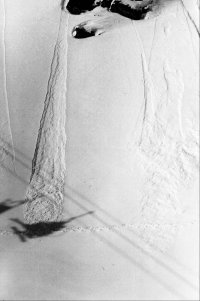Dynamics of granular surface flows
With Stéphane Douady and Bruno Andreotti (→ publications on granular flow)

The Dynamics of Avalanches, viz the onset and amplification of granular surface flows, was the subject of my PhD thesis, under the supervision of Stéphane Douady at the Laboratory for Statistical Physics of the École Normale Supérieure.

Granular matter can remain at rest with an inclined free surface, and starts moving spontaneously only above a critical angle of inclination. The amplitude and dynamics of the surface flow which then results is governed by the erosion and deposition of grains at the interface with the static phase. This solid-liquid transition is still not very well understood, despite its great importance not only for the understanding of natural avalanches, but also for industrial processing and transport of granular matter. I studied the transition in two different geometries.
In the first experiment, a layer of grains on a rough plane is put into a metastable equilibrium: in a range of inclinations the layer remains static if unperturbed, but a local perturbation triggers an avalanche. By measuring the minimal amplitude which could trigger an avalanche, I showed that the transition to the moving state is sub-critical.
Once the avalanche has been triggered, its mass and speed increase. With Stéphane Douady, we found two types of avalanches: one in which the layer is mobilized only downhill from the origin of the avalanche (triangular track), and another which eventually sets the whole layer in motion through an uphill-propagating front. We have studied the propagation mecanisms in both cases, finding for example a surprising saturation of the avalanche amplitude, which is linked to the presence of a rigid bottom.
The second experiment consists in studying the transient flow leading to the formation of a conical pile. The most striking finding was that the preparation of the granular packing has a big influence on the observed flow: varying the density by a few percent could double the duration of the flow. We also found a memory effect of anisotropic texture aquired during preparation.
The last part discusses common models for granular surface flows in the light of these results, and develops a new model based on conservation equations and experimental findings.
Last modified: 18 Jul 2020